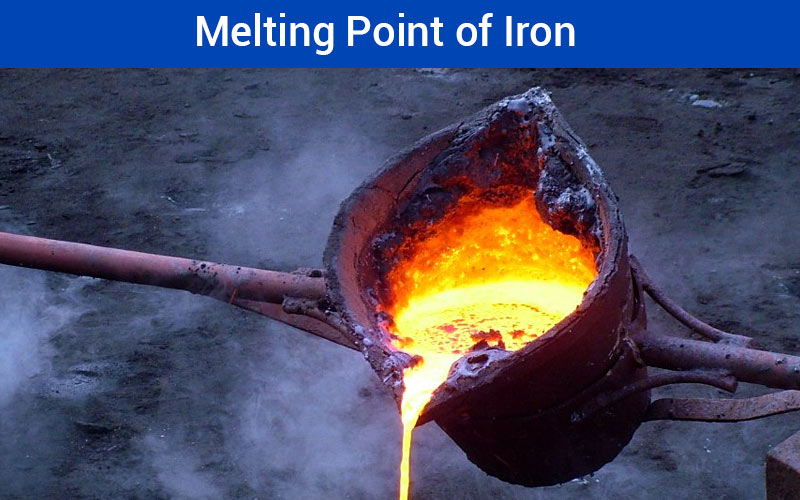The melting point of iron is a cornerstone of metallurgy, shaping everything from casting to aerospace design. This guide reveals iron’s precise melting temperature (1538°C), explores pressure and alloy impacts, compares it to other metals, and details measurement techniques. Master these insights to enhance industrial efficiency and material selection.
Content:
Contents
Precise Melting Point and Scientific Data of Iron
The exact melting point of iron is an important factor in the process of manufacturing. These are used by engineers to choose appropriate conditions for the manufacture of iron products.
Pure Iron vs. Cast Iron: Melting Point
The composition of casting applications is important. For each additional 1% carbon, pure iron’s melting point is also reduced by approximately 80°C—to 1200°C. Casts of gray and ductile iron, which have different percentages of carbon and silicon added, melt from 1150–1200°C. Try this shortcut for estimating the melting points of individual alloys: Melting Point (°C) = 1538 – (80 × %C) – (30 × %Si) – (5 × %Mn) + (20 × %Mo).
Surface Techniques for Iron Melting Point Testing
Differential scanning calorimetry (DSC) is the technique of choice for laboratory measurements; keep heating rates below 10°C/min in order to have sharp phase transitions. For foundries, optical pyrometry provides ±15°C accuracy—conventional calibration and emissivity setting practices help enhance results. Today’s systems typically use a combination of them for check and balance with each other.
| Measurement Method | Accuracy (±°C) | Best Application |
|---|---|---|
| Differential Scanning Calorimetry | 2-5 | Research & Development |
| Optical Pyrometry | 10-20 | Production Monitoring |
| Thermal Arrest Analysis | 5-10 | Quality Control |
| Direct Visual Observation | 25-50 | Field Testing |
Physical and Chemical Properties That Affect Iron’s Melting Point
Iron melting behavior is also shaped by both its atomic structure and alloying elements, which have implications on the selection of material and processing parameters in metallurgy.
Why Iron Melts at a Very High Temperature
Strong metallic bonding and electron delocalization in the d-orbital account for the high melting temperature of iron. For heat-resistant alloy calculations, subtract elements that interfere with that. Use caution: the body-centered cubic to face-centered cubic transition at 912°C, and the attendant change in thermal expansion, needs to be taken into account when making a very high-precision part. Chromium and molybdenum also increase the stability of the matrix at high temperatures.
Thermal Conductivity’s Role in the Melting of Iron
Iron’s relatively high thermal conductivity (around 80 W/m·K down to 35 W/m·K near melting) has an impact on heating uniformity. If it’s necessary to achieve full melt on much larger castings, hold longer as the resistance decreases. To increase the energy efficiency of induction furnaces, design coils taking into account the abrupt variation of the magnetic properties around 770°C.
Crystal Structure of Iron during Melting Transition Temperature at Different Pressures
Iron increases in volume by 3.5% as it melts—so mold and runner design need to accommodate this volume increase to prevent failure. The delta-ferrite phase starts to soften in the temperature range of 1400–1538°C, which results in a narrow plasticity range where deformation challenges are most prevalent. Use AE in real-time processing to identify phase transitions approaching full melt.

How Does Iron Melting Point Compare to Other Metals?
These relative melting data determine the choice of materials in high-temperature engineering.
Iron vs. Steel: Important Melting Point Distinctions
Melting temperature: Low-carbon steels (C 0.05-0.15%) have higher melting temperature (up to 1530°C) than high-carbon grades (as low as 1400°C). Melting behavior is affected by alloying components; 3°C per percent chromium; 4°C less per percent nickel. Select materials with a small melting range such as electrolytic iron or low alloy steels for precision casting.
Melting Points of Common Industrial Metals
Here’s how iron compares:
| Metal | °C |
|---|---|
| Melting Point of Aluminum | 660 |
| Melting Point of Copper | 1085 |
| Melting Point of Silver | 961.8 |
| Melting Point of Nickel | 1455 |
| Melting Point of Titanium | 1668 |
| Melting Point of Tungsten | 3422 |
For even higher temperature resistance, molybdenum and tantalum are also economical substitutes for tungsten.
Place of Iron in the Melting Point Order of the Periodic Table
It is just below chromium in Rockwell hardness and a little higher than cobalt in melting transition point. The melting point of iron is raised by alloying with group 5–6 elements (V, Cr, Mo, W), and decreased by additions of copper or zinc. This knowledge informs the design of an alloy with the desired thermal behavior.
Applications and Industrial Processes Associated with the Melting Point of Iron
Efficient methods of production depend on tailoring temperatures and techniques to iron’s peculiar melting behavior.
Iron Foundry and Casting Processes
Keep 100-150°C higher than the melting point of iron to enable full flow in the process of casting. Vary coke-to-iron ratios in cupolas to balance temperature and carbon control. Preheat scrap before charging into the furnace to decrease energy consumption 15%–20% and to prevent moisture defects. Sand casting can deal with ±50°C tolerance, but investment casting needs more accuracy (±15°C) for optimal performance.
Effect on Welding and Joining Technologies
Nickel fillers and preheating (300-400°C) help to avoid cracking when welding parts made of iron. Symmetric welding and step-back sequences should be used to control the effects of thermal stress. When welding iron to metals of unknown or dissimilar melting point, use methods other than fusion welding, such as explosion welding or friction welding, which avoid the risk of the soft metal being overheated.
Heat Treatment Operations Close to Melting Temperatures
Keep between 900–1000°C (65–70% of absolute melting temperature of iron) for annealing, to homogenize and soften, without melting. Avoid rising above 912°C for pure iron to avoid the unwanted phase transformation. Carburization at 900-950°C increases surface hardness without the hazard of melting. Sintering using powder metallurgy takes place safely at 1100 to 1300°C and with advantage for the diffusion and to maintain the shape of the part.
Modifiers of the Standard Melting Point of Iron
This sub-section informs about factors that influence iron’s melting temperature in powder metallurgical procedures. Knowledge of these factors enables the fine-tuning of sintering protocols as well as the enhancement of material characteristics.
Influence of Impurities and Alloying Elements
Impurities and alloying elements can modify iron’s melting point in different ways. For instance, carbon lowers the melting point of iron significantly at about 4.3 percent so that cast iron can be sintered and compacted. Silicon, however, raises the melting point by stabilizing ferrite. Low melting point compounds at the grain boundary are induced by sulfur and phosphorus, increasing the possibility of defects in processing.
| Element | Effect on Iron’s Melting Point | Approximate Impact |
|---|---|---|
| Carbon | Decreases | -10°C to -300°C (according to concentration) |
| Silicon | Increases | +5°C to +30°C per 1% input |
| Manganese | Slight decrease | Between -3°C and -10°C per 1% addition |
| Chromium | Increases | +10°C to +20°C per 1% addition |
To achieve good control of the melt behavior in powder metallurgy, design the alloy composition based on processing requirements and not only on general melt data.
Effect of Particle Size on Iron Powder Melting
It is well known that surface energy effects dominantly control the melting onset with respect to particle size. The melting point decreases by as much as 100°C for particle sizes below 100 nm in bulk iron. This is important for fine powders, where sintering temperatures must be lowered by 30–50°C for particles <10 μm to avoid liquid phase formation and associated shaping distortion of final parts.
Environmental/Operational Influences on Melting Mode Controls
The processing environment, pressure, and heating rates all change how and when iron melts. Oxidizing atmospheres will cause the surface to form high-melting oxides, but reducing atmospheres keep the metal’s properties intact. Pressures in excess of 5 GPa raise the melting point by 20°C (the melting point increases with pressure), but this is significant only in the most cutting-edge applications. Quick heating can cause visible defects. Keep heating rates low (less than 10°C/min) close to the desired sintering temperature to prevent uneven melting or temperature gradients.
History and Variability of the Melting Point of Iron
Reporting of the melting point of iron has changed through the years as technological advances have occurred. Variations among references are due to test and purity specifications rather than inherent variation.
Origin of Melting Point Data in Scientific Literature
Literature gives the melting point of iron values ranging between 1535°C and 1539°C. The source of differences is various laboratory conditions and synonymous variabilities. At standard pressure, it has a melting point and boiling point of 1538°C and 2836°C, respectively. For application purposes, use data from sources which state both purity and conditions when applicable powder metal technology is used.
| Reference Source | Reported Melting Point (°C) | Year Published |
|---|---|---|
| CRC Handbook of Chemistry and Physics | 1538 | Current edition |
| ASM Metals Handbook | 1537 | 2018 |
| Journal of Physical and Chemical Reference Data | 1538.2 | 2005 |
| NIST Standard Reference Database | 1538 | Current |
Differences Between Ancient and Modern Measurements and Nomenclature
Historically, ironworkers would have judged temperature purely on visual evidence, in particular based on color and behavior, leading to lower calculated temperatures (i.e., 1200–1300°C). They worked iron-carbon alloys, not pure iron. It would require true melting point measurements above 1500°C before they would have been able to measure it accurately with an optical pyrometer, which was only available in the late 19th century, and that set the accepted value.
FAQ
How Does the Melting Point of Iron Sulfide Stack Up?
Due to the lower melting point of iron sulfide (FeS, approximately 1194°C) relative to that of iron, it is melted from the OVB side. As it forms low-melting-point phases during sintering, it is an undesired impurity as it can cause local defects.
Is There a Melting Temperature Chart for Metals in Their Fully Melted States?
Yes. Reference charts are published by ASM International, CRC Press, and NIST. For powder metallurgy, there is specialist literature (though it tends to be concentrated around standard alloy systems rather than pure metals).
Applications: When Does Iron Actually Melt in Industry?
Under practical conditions in powder metallurgy, there is hardly ever full melting of the iron. The sintering occurs at a temperature of 1100–1350°C to keep the structure stable. This can often be accomplished by alloying, where the necessary temperatures are 150–300°C lower than those required to melt pure iron.
Does Pressure Dramatically Alter Iron’s Melting Point?
Only under extreme conditions. For every 1 GPa increase, the melting point of the powder may increase 10–12°C; however, typical powder metallurgy presses run at orders of magnitude less than this. Visible effects need special high-pressure apparatus.
What Color Does Iron Glow When Near Melting?
Iron will become bright yellow to white hot between 1400 and 1500°C, and experienced operators used this change in color as an indicator for process control when there were no suitable means of monitoring temperatures.



